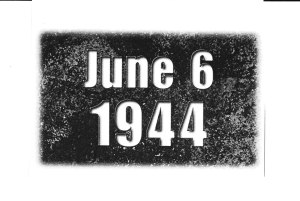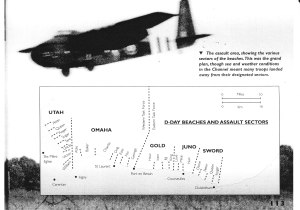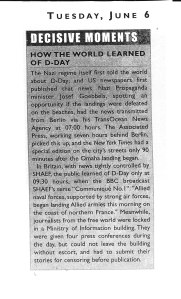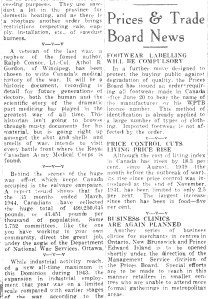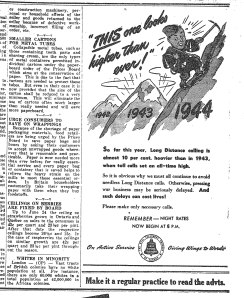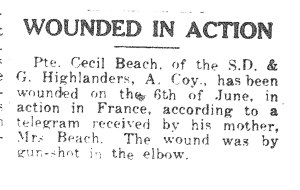Allied Forces Land In France Tuesday Morning
From
The Carleton Place Canadian
June 8, 1944
“Long Awaited D-Day Arrives when Thousands of Troops
Consolidate Position in French Territory
By Michael O’Mara
Canadian Press Staff Writer
D-Day arrived Tuesday when British, American and Canadian troops landed on the Normandy coast of France and began what Gen. Eisenhower called a crusade in which “we will accept nothing less than full victory.”
Initial landings of the greatest amphibious assault in history were preceeded by Allied heavy bombings of the invasion coast and were accompanied by a mammoth air cover, 11,00 aircraft in all taking part in the operations. Seaborne troops, headed by Gen. Montgomery surged across the Channel from England by 4,000 regular ships and additional thousands of smaller craft.
They were preceded by massed flights of parachute and glider forces who landed during the dark. More than 640 naval guns, ranging from 4 to 16-inch, hurled many tons of shells accurately into coastal fortifications which the Germans had spent four years preparing against this invasion day.
Initial German opposition in all quarters was less than expected and as aresult Allied losses, in all quarters was less than expected and as a result Allied losses, in general, were much less than expected. Losses of aircraft carring airborne troops was extremely small although the air-borne attack was on a very large scale.
A high officer at Allied headquarters described the landings as actually the third phase of the battle to crush Hitler, the first having been the gigantic air assault and the second the offensive in Italy.
At the same time word came from Moscow that the Russian army was massing in preparation for another great attack from the east as its part in defeating Germany.
The condition of the sea – the Channel was rough and there was a shower of rain at dawn on D-Day – caused some anxiety at supreme headquarters but the troops got ashore even though many were seasick.
Prime Minister Churchill told the British House of Commons on the day of the invasion that the operation was “undoubtedly the most complicated and difficult which has ever occurred.”
Lt.-Gen. H. D. G. Crerar, the Canadian Army commander, sent a personal message to Canadian assault forces on the eve of the invasion stating he has “complete confidence in our ability to meet the tests which lie ahead.” He said the Canadians would have a vital part to play in the assault.
“Plans, preparations, methods and technique which will be employed are based on knowledge and experience bought and paid for by the 2nd Canadian Division at Dieppe,” the message said.
“The contribution of that hazardous operation cannot be overestimated. It will prove to have been an essential prelude to our forthcoming and final success.”
Invasion of France was preceded by two days by the fall of Rome to Allied 5th Army units. American and Canadian infantrymen and tanks, after being resisted strongly at the Eternal city’s outskirts by hand-fighting rearguards, were the first to enter Italy’s capital.
As the invasion of France progressed beyond its first day, field dispatches declared that the invaders were making excellent progress and were biting deep into France. Allied invasion headquarters said only that satisfactory progress was being made but unofficial reports placed British, Canadian, and American invasion troops in possession of a 50 mile stretch of the French coast with the depth in some instances 12 miles or more.
Beachheads were reinforced during Tuesday night by airborne troops and from these operations came headquarters’ first announcement of losses suffered by the airborne section of the invasion. It was stated that 12 big transport planes and 12 gliders were missing from the night’s operations which saw a 50 mile long train of transports and gliders soar across the Channel.
Ross Munro, Canadian War Correspondent, reported from France that in two hours and 45 minutes fighting Canadian troops won their beachhead Tuesday and then shoved on inland. The strip of coast won by Canada’s soldiers was quite narrow but it provided a base for further penetration.”
The following are excerpts from the June 1944 editions of The Carleton Place Canadian:
